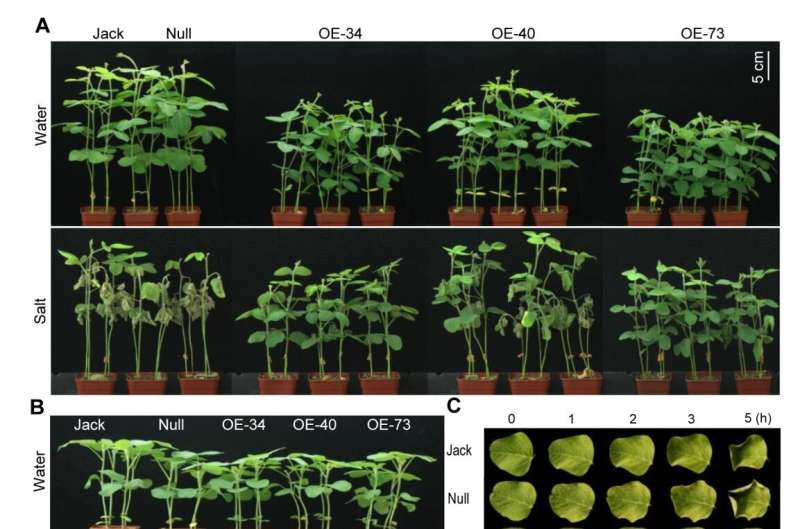This article has been reviewed according to Science X's editorial process and policies. Editors have highlighted the following attributes while ensuring the content's credibility:
fact-checked
trusted source
proofread
Researchers find new function of oil regulator GmZF351 in soybean stress tolerance

Soybean production is very limited in China. To increase the soybean yield, there is an urgent need to develop soybean varieties that can grow and adapt to the vast areas of saline, alkaline and arid lands.
A research team led by Prof Zhang Jinsong from the Institute of Genetics and Developmental Biology (IGDB) of the Chinese Academy of Sciences (CAS) reported the roles and mechanisms of a transcriptional regulator GmZF351 in salt and drought stress tolerance in stable transgenic soybean plants.
This study, titled "Zinc-finger protein GmZF351 improves both salt and drought stress tolerance in soybean," was published online in the Journal of Integrative Plant Biology.
Zhang's group previously discovered that the gene is highly expressed in soybean seeds and promotes oil accumulation in developing seeds. This gene shows little or no expression at the seedling and/or vegetative stage. However, under salt and other stresses, the gene is activated for stress tolerance in soybean.
They found that histone demethylation may be involved in such a transition. Under normal conditions, the histones are highly methylated at the promoter region of the GmZF351 gene. Upon salt treatment, two histone demethylase genes, JMJ30-1 and JMJ30-2, are activated, resulting in the removal of the histone H3K27me3 at the GmZF351 promoter and thus activation of the gene.
The researchers further analyzed the cis-elements bound by the zinc finger protein GmZF351. The element contains two of the motif CT(G/C)(T/A)AA for recognition. All the downstream genes involved in oil biosynthesis and stress tolerance have such features in their promoter regions. However, the GmZF351 activated different sets of genes for lipid accumulation in soybean seeds and in response to salt and drought stress.
For plants, it is costly and energy intensive to resist stress and survive for future generations. Therefore, stress tolerance and yield/storage accumulation must be fully considered during plant growth and development to complete the life cycle.
The newly identified gene GmZF351 can promote both oil accumulation in seeds and stress tolerance in seedlings, balancing these two important biological processes in different organs and at different developmental stages.
Understanding the dual functions of GmZF351 may shed light on the balancing mechanism of a crop for seed yield/storage and survival during crop domestication, and provide inspiring basis and insights for developing new soybean varieties suitable for unfavorable saline lands and environments.
More information: Wei Wei et al, Zinc‐finger protein GmZF351 improves both salt and drought stress tolerance in soybean, Journal of Integrative Plant Biology (2023). DOI: 10.1111/jipb.13474
Provided by Chinese Academy of Sciences



















